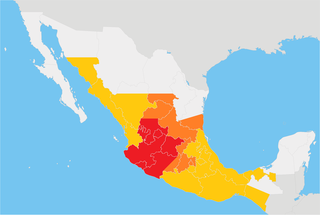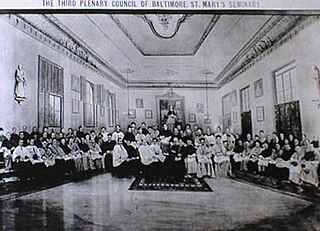Related Research Articles

The Council of Trent, held between 1545 and 1563 in Trent, now in northern Italy, was the 19th ecumenical council of the Catholic Church. Prompted by the Protestant Reformation at the time, it has been described as the embodiment of the Counter-Reformation.

Hernán Cortés de Monroy y Pizarro Altamirano, 1st Marquess of the Valley of Oaxaca was a Spanish conquistador who led an expedition that caused the fall of the Aztec Empire and brought large portions of what is now mainland Mexico under the rule of the king of Castile in the early 16th century. Cortés was part of the generation of Spanish explorers and conquistadors who began the first phase of the Spanish colonization of the Americas.

The Society of Jesus, also known as the Jesuit Order or the Jesuits, is a religious order of clerics regular of pontifical right for men in the Catholic Church headquartered in Rome. It was founded in 1540 by Ignatius of Loyola and six companions, with the approval of Pope Paul III. The society is engaged in evangelization and apostolic ministry in 112 nations. Jesuits work in education, research, and cultural pursuits. Jesuits also conduct retreats, minister in hospitals and parishes, sponsor direct social and humanitarian ministries, and promote ecumenical dialogue.

The Spanish colonization of the Americas began in 1493 on the Caribbean island of Hispaniola after the initial 1492 voyage of Genoese mariner Christopher Columbus under license from Queen Isabella I of Castile. These overseas territories of the Spanish Empire were under the jurisdiction of Crown of Castile until the last territory was lost in 1898. Spaniards saw the dense populations of indigenous peoples as an important economic resource and the territory claimed as potentially producing great wealth for individual Spaniards and the crown. Religion played an important role in the Spanish conquest and incorporation of indigenous peoples, bringing them into the Catholic Church peacefully or by force. The crown created civil and religious structures to administer the vast territory. Spanish men and women settled in greatest numbers where there were dense indigenous populations and the existence of valuable resources for extraction.

Our Lady of Guadalupe, also known as the Virgin of Guadalupe, is a Catholic title of Mary, mother of Jesus associated with a series of five Marian apparitions to a Mexican peasant named Juan Diego and his uncle, Juan Bernardino, which are believed to have occurred in December 1531, when the Mexican territories were under the Spanish Empire.
Anti-clericalism is opposition to religious authority, typically in social or political matters. Historical anti-clericalism has mainly been opposed to the influence of Roman Catholicism. Anti-clericalism is related to secularism, which seeks to separate the church from public and political life.

The Cristero War, also known as the Cristero Rebellion or La Cristiada, was a widespread struggle in central and western Mexico from 3 August 1926 to 21 June 1929 in response to the implementation of secularist and anticlerical articles of the 1917 Constitution. The rebellion was instigated as a response to an executive decree by Mexican President Plutarco Elías Calles to strictly enforce Article 130 of the Constitution, a decision known as the Calles Law. Calles sought to limit the power of the Catholic Church in Mexico, its affiliated organizations and to suppress popular religiosity.

The School of Salamanca is an intellectual movement of 16th-century and 17th-century Iberian Scholastic theologians rooted in the intellectual and pedagogical work of Francisco de Vitoria. From the beginning of the 16th the traditional Catholic conception of man and of his relation to God and to the world had been assaulted by the rise of humanism, by the Protestant Reformation and by the new geographical discoveries and their consequences. These new problems were addressed by the School of Salamanca. The name is derived from the University of Salamanca, where de Vitoria and other members of the school were based.

The Aztec Empire or the Triple Alliance was an alliance of three Nahua city-states: Mexico-Tenochtitlan, Tetzcoco, and Tlacopan. These three city-states ruled that area in and around the Valley of Mexico from 1428 until the combined forces of the Spanish conquistadores and their native allies who ruled under Hernán Cortés defeated them in 1521.

The Plenary Councils of Baltimore were three meetings of American Catholic bishops, archbishops and superiors of religious orders in the United States. The councils were held in 1852, 1866 and 1884 in Baltimore, Maryland.

Vasco de Quiroga was the first bishop of Michoacán, Mexico, and one of the judges (oidores) in the second Real Audiencia of Mexico – the high court that governed New Spain – from January 10, 1531, to April 16, 1535.
Stafford Poole, C.M was a Vincentian Catholic priest and a research historian. He was a former professor of history at the former St. John's Seminary College in Camarillo, California and later served as President. The college closed in 2002. He is also known for his extensive writings about the history of the Catholic Church in Mexico and the devotion to the Virgin of Guadalupe.

Martín de Azpilcueta, or Doctor Navarrus, was an important Spanish canonist and theologian in his time, and an early economist who independently formulated the quantity theory of money in 1556.

The Twelve Apostles of Mexico, the Franciscan Twelve, or the Twelve Apostles of New Spain, were a group of twelve Franciscan missionaries who arrived in the newly-founded Viceroyalty of New Spain on May 13 or 14, 1524 and reached Mexico City on June 17 or 18, with the goal of converting its indigenous population to Christianity. Conqueror Hernán Cortés had requested friars of the Franciscan and Dominican Orders to evangelize the Indians. Despite the small number, it had religious significance and also marked the beginning of the systematic evangelization of the Indians in New Spain.

The Catholic Church in Latin America began with the Spanish colonization of the Americas and continues up to the present day.
In civil law, obrogation is the modification or repeal of a law in whole or in part by issuing a new law.
The Third Mexican Provincial Council was a 1585 provincial council of the Catholic Church in the Archdiocese of Mexico. Unlike the first two Mexican Provincial Councils, it was approved by the Holy See. It called for reform of the repartimiento system of Indian labor.
The First Mexican Provincial Council was a 1555 provincial council of the Catholic Church in the Archdiocese of Mexico.
References
- ↑ Dussel, Enrique (1981). A History of the Church in Latin America: Colonialism to Liberation (1492-1979). Wm. B. Eerdmans Publishing. p. 56. ISBN 978-0-8028-2131-7.
- ↑ Claassen, Cheryl; Ammon, Laura (10 February 2022). Religion in Sixteenth-Century Mexico: A Guide to Aztec and Catholic Beliefs and Practices. Cambridge University Press. p. 54. ISBN 978-1-009-00631-6.
- ↑ Stevenson, Robert. Music in Aztec & Inca Territory. University of California Press. p. 169.
- ↑ O'Hara, Matthew D. (2010). A Flock Divided: Race, Religion, and Politics in Mexico, 1749–1857. Duke University Press. p. 74. ISBN 978-0-8223-4639-5.
- ↑ Galindo, Rex (22 January 2024). Bragagnolo, Manuela (ed.). The Production of Knowledge of Normativity in the Age of the Printing Press: Martín de Azpilcueta’s Manual de Confessores from a Global Perspective. Brill. p. 330. ISBN 978-90-04-68704-2.